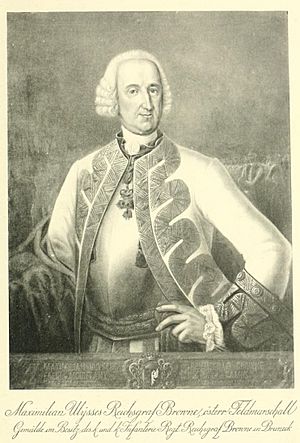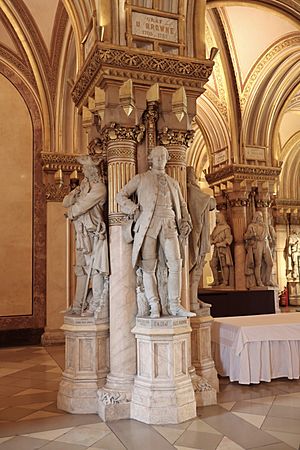Maximilian Ulysses Browne facts for kids
Quick facts for kids
Maximilian Ulysses Browne
|
|
|---|---|

Maximilian Ulysses Browne (18th-century painting)
|
|
| Born | 23 October 1705 Basel, Swiss Confederation |
| Died | 26 June 1757 (aged 51) Prague, Kingdom of Bohemia |
| Allegiance | |
| Rank | Field marshal |
| Awards | Order of the Golden Fleece |
Maximilian Ulysses Browne was a very important military leader in Austria during the 1700s. He was born on October 23, 1705, and passed away on June 26, 1757. Even though he served Austria, his family originally came from Ireland. They were part of a group called the "Wild Geese," which were Irish soldiers who left Ireland to serve in armies across Europe. Maximilian became one of the highest-ranking officers for the Habsburg Emperor.
Contents
Browne's Family Background
Maximilian was born in Basel, Switzerland. His father, Count Ulysses von Browne, was born in Limerick, Ireland. His mother was Annabella Fitzgerald. Both of their families had to leave Ireland after a conflict called Tyrone's Rebellion. This meant Maximilian grew up in a family that had moved to a new country.
Starting His Military Career
Maximilian's early career in the military was helped by his family. His father and uncle were made Counts of the Holy Roman Empire in 1716. This was because they had served the Holy Roman Emperors very well. These brothers were also good friends with a famous general, John Churchill, 1st Duke of Marlborough. This friendship helped them get started in the Austrian army.
When his father died in 1731, Maximilian became the third Earl of Browne. His wife, Countess Marie Philippine von Martinitz, also had important connections at court. His sister, Barbara, was married to a Major General in the Austrian army. Because of these connections, Maximilian became a colonel of an Austrian infantry regiment by the age of 29.
However, he proved himself to be a skilled leader in battles. In 1734, he showed great bravery in a campaign in Italy. He also gained more recognition as a general in 1735 during fighting in Tyrol and later in a war against the Turks.
War of the Austrian Succession
In 1740, Maximilian was a lieutenant field marshal in charge of soldiers in Silesia. This was when Frederick II of Prussia and his army invaded the area. Maximilian used his soldiers carefully, which slowed down Frederick's conquest. This gave Austria time to gather a larger army.
Maximilian was hurt in the Battle of Mollwitz. He often disagreed with his superiors because he wanted to take strong actions. However, his determination helped the Austrian armies fight with great energy in 1742 and 1743.
In later battles, Maximilian continued to show his skills as a general. In 1745, he was promoted to Feldzeugmeister. In 1746, he fought in Italy at the battles of Piacenza and Rottofreddo. Maximilian led his soldiers across the mountains and entered Genoa. He was then put in charge of an invasion of France in the winter of 1746–1747. However, he had to stop the invasion and return to Italy in February 1747. This was because the people of Genoa rebelled against the Austrian soldiers he had left there.
In early 1747, he became the commander of all Austrian forces in Italy. After the war ended, Maximilian helped with talks about removing troops from Italy. In 1751, he became the commander-in-chief in Bohemia. Two years later, he was promoted to Field Marshal.
Seven Years' War
Maximilian was still in Bohemia when the Seven Years' War began in 1756. Frederick of Prussia invaded Saxony. Maximilian's army tried to help the city of Pirna, but they were defeated by Frederick at the Battle of Lobositz. However, Maximilian managed to lead his army away in good order. He then tried again to reach Pirna with a special group of soldiers, using difficult mountain paths.
Maximilian was a dedicated leader. He would even sleep in the snow with his soldiers. He managed to reach the Elbe River, but the Saxon soldiers could not break out of Pirna. So, Maximilian had to retreat. However, his actions delayed Frederick's plans for a whole year.
In 1757, Maximilian chose to serve under Prince Charles Alexander of Lorraine, who was the new commander-in-chief. On May 6, 1757, Maximilian was leading a charge with bayonets at the Battle of Prague. He was badly wounded and carried into Prague. He died there on June 26.
Maximilian's Family
Maximilian had two sons: Philip George (1727–1803) and Joseph Ulysses (1728–1758). His younger son, Joseph, took over his father's regiment but was killed in battle in 1758. His older son, Philip, became a lieutenant-general. Philip was also one of the first members of the military order of Maria Theresa. Philip was the fourth Earl of Browne. The family line ended when Philip died without children in 1803.
Honors and Recognition
From 1888 to 1918, the 36th Austrian infantry regiment was named after Maximilian Ulysses Browne to honor him.
| Military offices
|
||
|---|---|---|
| Preceded by Franz Paul von Wallis |
Proprietor (Inhaber) of Infantry Regiment N°36 1737–1757 |
Succeeded by Joseph Browne |
See also


